
The coat of arms of the Philippines features the eight-rayed sun of the Philippines with each ray representing the eight provinces which were placed under martial law by Governor-General Ramón Blanco Sr. during the Philippine Revolution, and the three five-pointed stars representing the three major island groups of Luzon, the Visayas, and Mindanao.

Ruthenian and Ruthene are exonyms of Latin origin, formerly used in Eastern and Central Europe as common ethnonyms for Ukrainians and partially Belarusians, particularly during the late medieval and early modern periods. The Latin term Rutheni was used in medieval sources to describe Eastern Slavs of the Grand Duchy of Lithuania, as an exonym for people of the former Kievan Rus', thus including ancestors of the modern Belarusians, Rusyns and Ukrainians. The use of Ruthenian and related exonyms continued through the early modern period, developing several distinctive meanings, both in terms of their regional scopes and additional religious connotations.

The pan-Slavic colors—blue, white and red—were defined by the Prague Slavic Congress, 1848, based on the symbolism of the colors of the flag of Russia, which was introduced in the late 17th century. Historically, however, many Slavic nations and states had already adopted flags and other national symbols that used some combination of those three colors. Slavic countries that use or have used the colors include Russia, Yugoslavia, Czechoslovakia, Czech Republic, Slovakia, Croatia, Serbia and Slovenia, whereas Belarus, Bosnia and Herzegovina, Bulgaria, Montenegro, North Macedonia, Poland and Ukraine use different color schemes.

Three Crowns is the national emblem of Sweden, present in the coat of arms of Sweden, and composed of three yellow or gilded coronets ordered two above and one below, placed on a blue background. Similar designs are found on a number of other coats of arms or flags.
Transcarpathia is a historical region on the border between Central and Eastern Europe, mostly located in western Ukraine's Zakarpattia Oblast.

The coat of arms of Bosnia and Herzegovina was adopted in 1998, replacing the previous design that had been in use since 1992 when Bosnia and Herzegovina gained independence. It follows the design of the national flag. The three-pointed shield is used to symbolize the three major ethnic groups of Bosnia, as well as allude to the shape of the country.
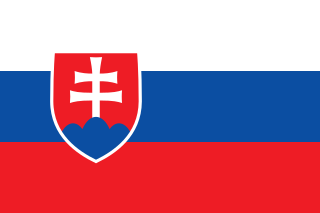
The current form of the national flag of the Slovak Republic was adopted by Slovakia's Constitution, which came into force on 3 September 1992. The flag, like many other flags of Slavic nations, uses Pan-Slavic colours. Pictured to the left of centre of the flag is Slovakia's national coat of arms.
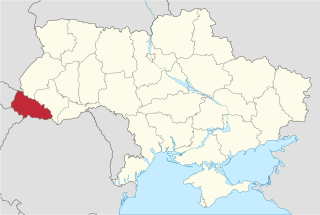
Zakarpattia Oblast, also referred to as simply Zakarpattia or Transcarpathia in English, is an oblast located in the Carpathian Mountains in west Ukraine, mostly coterminous with the historical region of Carpathian Ruthenia. Its administrative centre is the city of Uzhhorod. Other major cities within the oblast include Mukachevo, Khust, Berehove, and Chop, the last of which is home to railroad transport infrastructure.

Rusyns, also known as Carpatho-Rusyns, Ruthenians, or Rusnaks, are an East Slavic ethnic group from the Eastern Carpathians in Central Europe. They speak Rusyn, an East Slavic language variety, treated variously as either a distinct language or a dialect of the Ukrainian language. As traditional adherents of Eastern Christianity, the majority of Rusyns are Eastern Catholics, though a minority of Rusyns practice Eastern Orthodoxy. Rusyns primarily self-identify as a distinct Slavic people and they are recognized as such in Croatia, Hungary, Poland, Romania, Serbia, and Slovakia, where they have official minority status. Alternatively, some identify more closely with their country of residence, while others are a branch of the Ukrainian people.
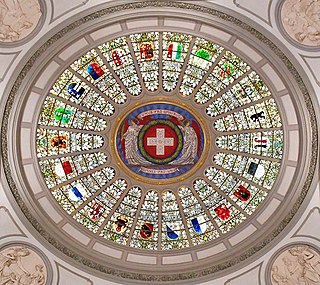
Each of the 26 modern cantons of Switzerland has an official flag and a coat of arms. The history of development of these designs spans the 13th to the 20th centuries.

The coat of arms of Malta is the national coat of arms of the country of Malta.

The coat of arms of the Slovak Republic consists of a red (gules) shield, in early Gothic style, charged with a silver (argent) double cross standing on the middle peak of a dark blue mountain consisting of three peaks. Extremities of the cross are amplified, and its ends are concaved. The double cross is a symbol of its Christian faith and the hills represent three symbolic mountain ranges: Tatra, Fatra, and Matra.
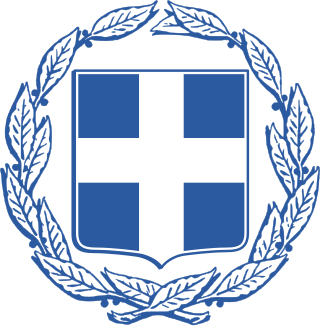
The coat of arms of Greece or national seal of Greece comprises a white Greek cross on a blue escutcheon, surrounded by two laurel branches. It has been in use in its current form since 1975. Prior to the adoption of the current coat of arms, Greece used a number of different designs, some of which were not heraldic; the first heraldic design was introduced in 1832 and its main element, the blue shield with the white cross, has been the base for all other national coats of arms since then. The design is a heraldic representation of the Greek national flag adopted in 1822, which featured a white cross on a blue field.

The coat of arms of Portugal is the main heraldic insignia of Portugal. The present model was officially adopted on 30 June 1911, along with the present model of the Flag of Portugal. It is based on the coat of arms used by the Kingdom of Portugal since the Middle Ages. The coat of arms of Portugal is popularly referred as the Quinas.

The Carpatho-Rusyn Society is a non-profit cultural organization located in the United States dedicated to promoting Carpatho-Rusyn culture and history. It was established in Pittsburgh in 1994 and is the largest exclusively Carpatho-Rusyn organization in North America with over 3,000 members.
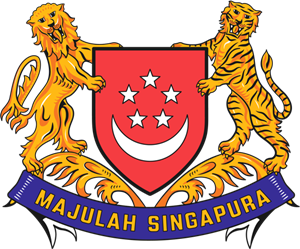
The coat of arms of Singapore is the heraldic symbol representing the sovereign island country and city-state of Singapore located in maritime Southeast Asia. It was adopted in 1959, the year Singapore attained self-governance from the British Empire, and remains in use after its independence in 1965. The committee that created it, headed by Toh Chin Chye, who was also responsible for the national flag and the national anthem of Singapore.

World Congress of Rusyns is the central event of the international Rusyn community. Its executive committee is called the World Council of Rusyns and currently has ten members: nine representing various countries in which most Rusyns live, and one ex officio voting member, the current chairperson of the World Forum of Rusyn Youth. The longtime chairman of the Congress was historian Paul Robert Magocsi, who now holds the title of Honorary President.
The national symbols of North Macedonia, as stated in the constitution, are the coat of arms, the flag and the anthem. After the independence of North Macedonia from Yugoslavia, the country made some changes in the national symbols. The flag was changed two times and today's flag includes an eight-ray sun on a red background, while the coat of arms from the Socialist Republic of Macedonia was retained, except the red star which was removed.

The coat of arms of Carpatho-Ukraine is the official heraldic coat of arms of Zakarpattia Oblast in Ukraine. The coat of arms was initially adopted on 30 March 1920 along with coat of arms of other lands of Czechoslovakia. The Ukrainian version of the arms was adopted on 18 December 1990 as a revived coat of arms by Hungarian graphic artist Janos Reiti.

The flag of Surrey is the blue and gold chequered flag of the traditional county of Surrey and is derived from the coat of arms of William de Warenne, 2nd Earl of Surrey who adopted arms similar of the Capetian Count of Vermandois on his marriage to Elizabeth, Countess of Leicester, who was first married to Robert de Beaumont, 1st Earl of Leicester. She was a younger daughter of Hugh I, Count of Vermandois (1057–1102). Similar arms were also adopted by his brother in law, Ralph I de Beaugency, who married Hugh I's oldest daughter, Matilda. (heraldic blazon: Chequy Or and Azur).






















